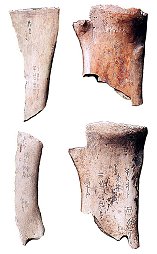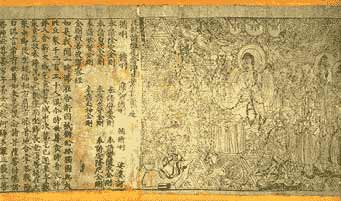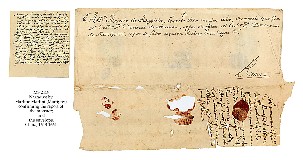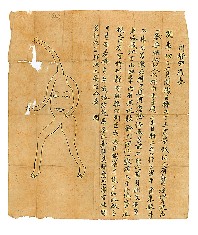|
| |
Major Acquistion
Ancient Chinese Library
| #10
ORACLE BONE: CRACKING MADE ON THE XINHAI
(DAY 48); NO QUICK VICTORY ON THE YIN (DAY 51?). APPROVED. IT WILL RAIN ON JIAHAI (?) 
MS in Chinese on oxen scapula bone, Xiaotun, China, 14th-12th c. BC, 1 bone, 4+2
lines in Chinese script, prepared and cracked with burned marks on reverse.
Context: Around 100,000 oracle bones are known, widely scattered in museums and
collections around the world.
Provenance: 1. Royal archive of oracular records, Late Shang Dynasty of Anyang
(14th-12th c. BC); 2. Excavated in Xiaotun (ca. 1945)
Commentary: Nearly all known Chinese oracle bones derive from Xiaotun near the
ancient capital of the Late Shang Dynasty of Anyang. The oracular use of the bones
involved the interpretation of pattern of cracks which appeared on the bones after
subjection to heat by the application of a heated metal rod. The text records the
interpretation of the oracle and the date of its production. The oracle bones are so far
the first preserved evidence of Chinese script in complete meaningful sentences. |
Origins of Chinese Writing

Oracle Bones
The earliest examples of Chinese writing date to the late Shang period (ca. 1200 BC).
These are the so-called Oracle Bone Inscriptions (jiaguwen) which were found at the site
of the last Shang capital near present-day Anyang, Henan province.
The discovery of the oracle bones in China goes back to 1899, when a scholar from
Peking was prescribed a remedy containing "dragon bones" for his illness:
"dragon bones" were widely used in Chinese medicine and usually refer to fossils
of dead animals. The scholar noticed some carvings that looked like some kind of writing
on the bones he acquired from the local pharmacy. This lucky find led eventually to the
discovery of Anyang, the last capital of Shang dynasty where archeologists have found an
enormous amount of these carved bones.
The inscriptions on these bones tell us that by 1200 BC Chinese writing was already a
highly developed writing system which was used to record a language fairly similar to
classical Chinese. Such a complex and sophisticated script certainly has a history but so
far we found no traces of its predecessors.
The oracle bone inscriptions received their name after their content which is
invariably related to divination. The ancient Chinese diviners used these bones as records
of their activity, providing us with a detailed description of the topics that interested
the Shang kings. Most of these divinations refer to hunting, warfare, weather, selection
of auspicious days for ceremonies, etc.
Bronze Inscriptions

The next stage in the history of Chinese writing is the bronze inscriptions (jinwen).
These are texts either casted into bronze vessels or carved into the surface of an already
carved vessel. These vessels became widely used during the Eastern Zhou dynasty (ca.
1150-771 BC) but there are examples from late Shang as well.
Since the inscriptions are located on ritual vessels which were used for performing
sacrifices, their content usually refers to ritual ceremonies, commemorations etc.
Although most of these writings consist of only a few characters, there are some which
contain quite lengthy descriptions. The language and calligraphic style at this stage is
similar to that found on the oracle bones. |
#11 The Diamond
Sutra:
The World's Earliest Dated Printed Book
 Copyright © 1997, The
British Library Board Copyright © 1997, The
British Library Board
British Library, Or. 8210/P.2.
Jin gang ban ruo bo luo mi jing. (The Sanskrit Vajracchedika-prajnaparamitasutra,
translated into Chinese by Kumarajiva.) The Diamond Sutra of AD 868.
Frontispiece (detail), showing the Buddha preaching to his aged disciple Subhuti Click for a close up.
This scroll was found in 1907 by the archaeologist Sir Marc Aurel Stein in a walled-up
cave at the 'Caves of the
Thousand Buddhas', near Dunhuang, in North-West China. It was one of a small number of
printed items among many thousands of manuscripts, comprising a library which must have
been sealed up in about AD 1000. Although not the earliest example of blockprinting, it is
the earliest which bears an actual date. The colophon, at the inner end, reads:
`Reverently [caused to be] made for universal free distribution by Wang Jie on behalf of
his two parents on the 13th of the 4th moon of the 9th year of Xiantong [i.e. 11th May, AD
868]'.
The technique of blockprinting had been known in the Far East for well over 100 years
by 868, and the quality of this illustration makes it clear that the blockcutter had a
considerable period of experience and skill behind him. It is not known where the printing
was carried out, although Sichuan, in south-west China, is known to have been a centre of
printing activity at this time.
Turn the pages of
the Diamond Sutra online |
 |
#12
SUTRA OF PERFECT ENLIGHTENMENT
By DAFANGGUANG YANJUE XIUDUOLUO LIAOYI JING. BELIEVED TRANSLATED BY THE INDIAN MONK,
BUDDHATRATA
MS in Chinese on dark blue paper, China, late 14th c., 174 ff. (complete), 17
characters in Chinese book script in gold ink, 6 ff. miniatures in gold and white, with
frontispiece depicting the Historical Buddha, Sakyamuni seated on a throne surrounded by 9
disciples and 5 Bodhisattvas on each side.
|
| #13 REPORT OF A
MONSTER SENT TO THE EMPEROR FROM E WEI, GOVERNOR OF SICHUAN
PROVINCE. NARRATIVE BY MARTINO MARTINI (MARTIGNY) CONFIRMING THE REPORT

MS in Chinese and Italian (text 2) on paper, Sichuan province, China, 1643-1661, 1+1
ff., 27x31 cm, 8 columns, 23-27 characters in Chinese script, full-page drawing of the
monster; text 2: 7x6 cm, single column, 11 lines in a small cursive Italian script.

Provenance: 1. E Wei, Governor of
Sichuan Province, China (mid 17th c.); 1. Martino Martini, China (mid 17th c.); 2. Office
of Cardinal Tournon, Catholic Patriarch of Antioch, (ca. 1710)
Commentary: From the report: Several soldiers, including Ding Wanghu, discovered
in Guo Duoli a beast with a human body, but no head, and instead a hand growing from his
neck. It has eyes on its belly and a mouth on its belly bottom. This beast came to the
army camp and ate rice, but caused no harm to any people or animals. --- Later the
soldiers chased him to a place called La Ha Huo. There, in the valley, there were many
deep caves, and the beast jumped into one of them, where the soldiers discovered hundreds
of these beasts ---. The Jesuit Martino Martini (b. 1614), lived in China 1643-1661. He
was a geographer, and prepared the first modern atlas of China. |
| The Question: 1. In his studies of ethics, Kohlberg concluded that boys reach
a higher level of moral development than girls. Gilligan showed that Kohlberg's
tests were biased and only revealed that boys tend to favor principled means of reasoning,
whereas girls prefer moral argumentation that concentrates on relations. This
realization initiated a view of an "ethics of care" in contrast to an
"ethics of justice". (Kohlberg later revised his scoring methods based on
Gilligan's findings). From what we have learned so far, what does this tell us about
tests, statistics and systems? |
|